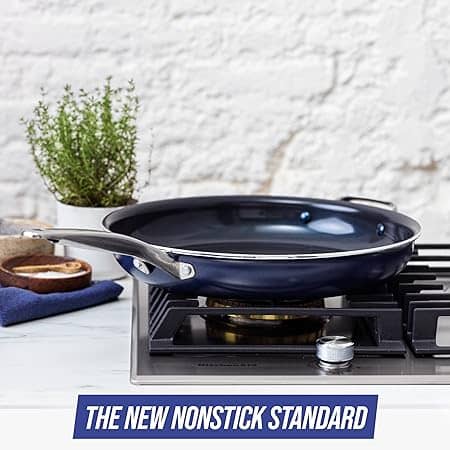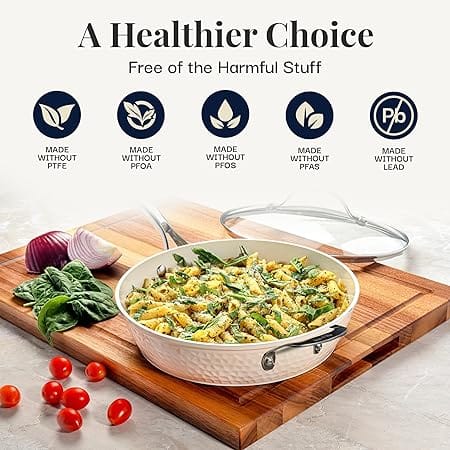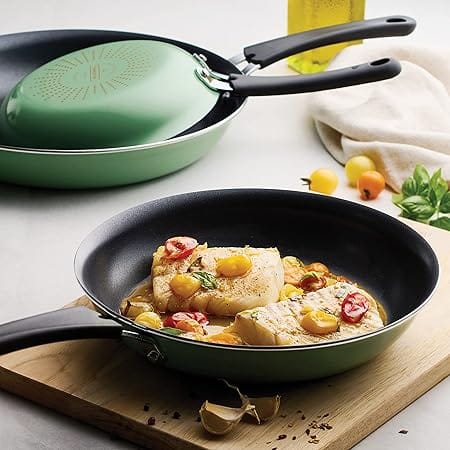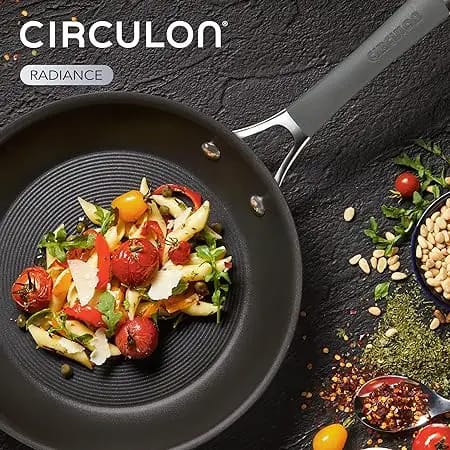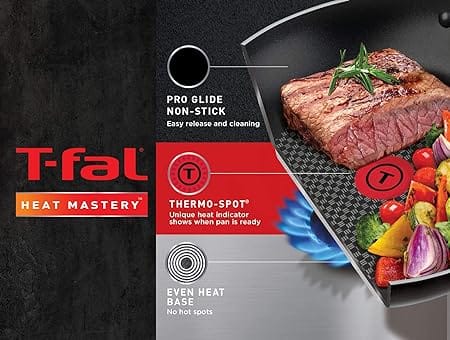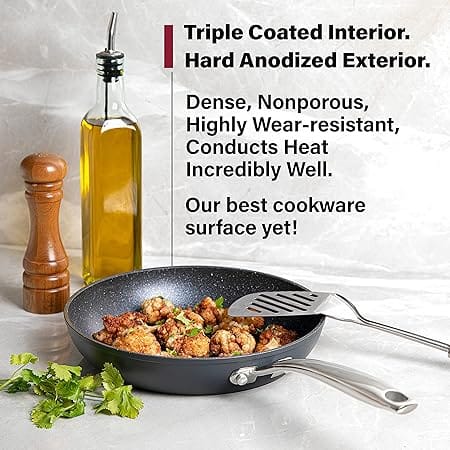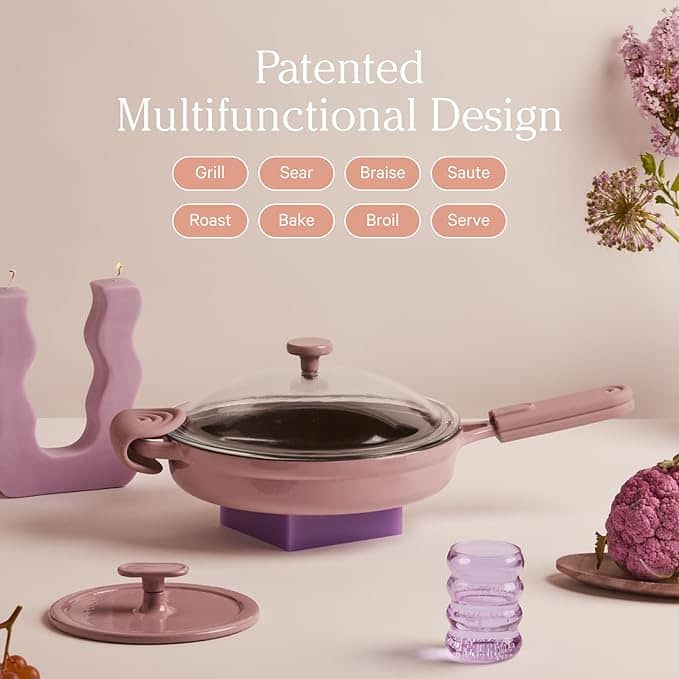Need a Frying Pan for Everything? Try a 14-inch Frying Pan
Table of Contents
Have you ever stared at your collection of frying pans, wondering if there’s one pan that can truly do it all? Well, wonder no more! The 14-inch frying pan might just be the missing piece in your kitchen arsenal.
This versatile pan strikes a perfect balance between size and functionality, allowing you to whip up everything from perfectly seared steaks to hearty family meals. But with so many factors to consider, choosing the right 14-inch frying pan and mastering its techniques can feel overwhelming. Fear not! This comprehensive guide will equip you with all the knowledge you need to become a 14-inch frying pan pro.
Introduction 14-inch frying pan
A 14-inch frying pan, also sometimes referred to as a jumbo or family-sized frying pan, boasts a diameter of 35.5 centimeters (roughly 14 inches). Compared to its smaller cousins, the 10-inch and 12-inch pans, the 14-inch pan offers a significantly larger cooking surface area. This translates to more freedom for maneuvering ingredients, accommodating larger cuts of meat or fish, and preparing generous portions for the whole family.
Here’s why a 14-inch frying pan might be the perfect addition to your kitchen:
- Versatility: This pan can handle a wide range of cooking tasks, from searing steaks and fajitas to whipping up one-pan pasta dishes and paella.
- Ideal for family meals: The larger surface area allows you to cook enough food to feed a crowd, eliminating the need for multiple pans.
- Space-saving potential: A single 14-inch pan can replace the need for several smaller pans for specific jobs, decluttering your cookware collection.
Choosing the Right 14-inch Frying Pan for You
Now that you’re sold on the potential of a 14-inch frying pan, it’s time to navigate the exciting world of materials and features. Choosing the right pan depends on your cooking style, preferred heat source, and desired features. Here’s a breakdown of key factors to consider:
Material Considerations
The material of your 14-inch frying pan significantly impacts its cooking performance, durability, and cleaning requirements. Here are the three most common materials to consider:
- Stainless Steel: A classic choice known for its durability and versatility. Stainless steel pans excel at achieving high heat for searing and offer even heat distribution. However, they typically require more oil to prevent sticking and can be heavier than other options.
- Nonstick: Perfect for cooks who prioritize easy cleanup and minimal sticking. Nonstick pans come with a variety of coatings, each with varying degrees of durability and heat tolerance. Be mindful of using these pans on medium heat to preserve the coating’s lifespan.
- Cast Iron: Beloved by chefs for its exceptional heat retention and even cooking. Cast iron pans are nearly indestructible and can handle high heat beautifully. However, they require seasoning for optimal performance and are not dishwasher-safe.
Comparison of Common 14-inch Frying Pan Materials
Material | Pros | Cons |
Stainless Steel | Durable, Versatile, Even Heat Distribution | Requires more oil, Heavier |
Nonstick | Easy Cleanup, Minimal Sticking | Not ideal for high heat, Coating can wear down |
Cast Iron | Excellent Heat Retention, Durable | Requires seasoning, Not dishwasher safe |
Additional factors to consider:
- Ceramic: Similar to nonstick in terms of cooking properties, but often touted as a more eco-friendly option.
- Copper: Highly conductive for exceptional heat control, but typically more expensive and requires special care.
Heat Source Compatibility
Not all frying pans are created equal when it comes to heat sources. Here’s a quick guide to ensure compatibility:
- Gas Stoves: Most frying pan materials work well with gas stoves, including stainless steel, cast iron, and nonstick (check the manufacturer’s instructions for heat limitations on nonstick).
- Electric Stoves: Electric stoves work with all pan materials, but heavier pans like cast iron may distribute heat more evenly.
- Induction Cooktops: Induction cooktops require pans with a magnetic base, typically made of cast iron or stainless steel with a ferrous metal disc incorporated into the bottom.
Additional Features to Consider
While material and heat source compatibility are crucial, there are other features that can enhance your cooking experience:
- Handle Design: Look for a comfortable, heat-resistant handle that provides a secure grip, especially for heavier pans like cast iron.
- Oven-Safe: Opt for an oven-safe pan if you plan to use it for recipes that transition from stovetop to oven (think finishing a frittata or creating a pan sauce).
- Dishwasher-Safe: While not all materials are dishwasher-safe (cast iron!), this feature can be a major convenience for busy cooks (double-check the manufacturer’s recommendations).
By considering these factors, you’ll be well on your way to selecting the perfect 14-inch frying pan that complements your cooking style and kitchen setup
Mastering Your 14-Inch Frying Pan
Now that you’ve chosen your trusty 14-inch frying pan companion, it’s time to unleash its potential in the kitchen! This versatile pan can tackle a variety of cooking techniques, allowing you to create restaurant-quality dishes at home.
Perfecting Common Cooking Techniques
- Searing: A 14-inch pan is ideal for searing meat due to its large surface area. Here’s how to achieve a restaurant-worthy sear:
- Preheat your pan over medium-high heat with a high smoke point oil (avocado oil, canola oil).
- Pat your meat dry with paper towels to remove excess moisture, which can prevent browning.
- Once the pan is hot, carefully place your meat in the pan and resist the urge to move it around. Let it sear undisturbed for a few minutes to develop a beautiful crust.
- Once seared, use tongs to flip the meat and cook to your desired doneness.
- Crispy Frying: Who doesn’t love perfectly crisp fried food? Here’s the key to achieving that golden perfection:
- Choose the right oil for frying. Opt for oils with high smoke points, like peanut oil or vegetable oil.
- Heat your oil in the pan over medium heat. You can test the oil temperature by dropping a small piece of breadcrumb in the oil. If it sizzles and floats immediately, the oil is hot enough.
- Don’t overcrowd the pan. Fry food in batches to maintain proper oil temperature and ensure even cooking.
- Once golden brown and cooked through, transfer fried food to a paper towel-lined plate to drain excess oil.
- Deglazing the Pan: Don’t discard those flavorful pan drippings after searing or browning! Deglazing the pan adds depth and complexity to sauces and gravies. Here’s how:
- Once you’ve removed your cooked food from the pan, add a small amount of liquid (wine, broth, or even water) to the hot pan.
- Using a spatula, scrape up any browned bits stuck to the bottom of the pan, incorporating them into the liquid. This deglazed liquid becomes the base for your pan sauce, ready to be reduced and seasoned to taste.
Ideal Dishes for a 14-inch Frying Pan
The beauty of a 14-inch frying pan lies in its versatility. Here are some recipe ideas perfectly suited for this wonder pan:
- One-Pan Pasta Dishes: Simplify your weeknight meals with one-pan pasta dishes. Sauté your vegetables and protein in the pan, then add broth, pasta, and seasonings. Let the pasta simmer until cooked through, absorbing all the delicious flavors.
- Paella: This traditional Spanish rice dish is a crowd-pleaser. A 14-inch pan provides ample space to cook the chicken, seafood, vegetables, and rice together, ensuring an even distribution of flavors.
- Fajitas: Sizzle up colorful fajitas with ease in your 14-inch pan. Marinate your chicken or steak strips, then char them in the pan with bell peppers and onions. Serve with warm tortillas and your favorite toppings for a fun and interactive meal.
Adapting Recipes for a 14-Inch Pan:
Many recipes can be easily adapted for a 14-inch pan. Simply adjust the ingredient quantities proportionally to ensure everything cooks evenly. For instance, if a recipe is designed for a 12-inch pan, you may need to increase the amount of vegetables or protein by 1/3 to accommodate the larger surface area.
Cleaning and Maintenance
Proper cleaning and maintenance will ensure your 14-inch frying pan stays in tip-top shape for years to come. Here are some tips based on the pan material:
- Stainless Steel: Allow the pan to cool slightly before washing. Wash with warm soapy water and a soft sponge. For stubborn stains, you can use a baking soda paste or a stainless steel cleaner.
- Nonstick: Avoid using harsh abrasives or metal utensils that can scratch the nonstick coating. Wash with warm soapy water and a soft sponge.
- Cast Iron: Cast iron requires seasoning to develop a nonstick surface. Wash with hot water and a coarse salt scrub after use. Avoid using soap, as it can strip away the seasoning. Dry thoroughly with a clean cloth to prevent rust.
Bonus Tip: Store your frying pans in a cool, dry place to prevent warping or scratches.
With a little practice and these helpful tips, you’ll be a 14-inch frying pan pro in no time
Troubleshooting Common Issues with 14-Inch Frying Pans
Even the most seasoned cooks can encounter occasional challenges with their 14-inch frying pans. Here are some common issues and solutions to keep your cooking experience smooth:
- Uneven Cooking:
- Cause: Uneven heat distribution can lead to hot spots in the pan, resulting in unevenly cooked food.
- Solution:
- Use a pan material known for even heat distribution, like cast iron or certain stainless steel pans with a thick base.
- Preheat your pan properly over medium heat for several minutes before adding your food. This allows the entire pan to reach a consistent temperature.
- Avoid overcrowding the pan. This can trap steam and prevent even browning.
- Sticking Food:
- Cause: This can be caused by several factors, including using the wrong amount of oil, not preheating the pan enough, or using a pan material that isn’t properly seasoned (cast iron).
- Solution:
- Use the right amount of oil for your cooking method. For searing, use a high smoke point oil and allow it to get hot before adding your food.
- Preheat your pan sufficiently before adding food. This ensures a proper sear that prevents sticking.
- If using cast iron, make sure it’s well-seasoned for a naturally nonstick surface.
- Consider using a nonstick pan for delicate foods that are prone to sticking.
- Warping:
- Cause: This is a concern primarily with pans made of thin, low-quality materials. Extreme temperature changes or overheating can cause the pan to warp.
- Solution:
- Invest in a pan made from a sturdy material that resists warping, such as thick gauge stainless steel or cast iron.
- Avoid overheating your pan. Use medium heat for most cooking tasks and adjust only as needed for specific recipes.
- Never place a hot pan directly on a cold surface, such as a countertop. Let it cool gradually on a heat-resistant pad.
By understanding these common issues and their solutions, you can ensure your 14-inch frying pan remains a reliable and versatile tool in your kitchen for years to come.
Conclusion
The 14-inch frying pan offers a unique combination of size, versatility, and functionality. With the right knowledge and a little practice, you can master this pan and unlock a world of culinary possibilities. So, ditch the single-use mentality and embrace the convenience and efficiency of the 14-inch wonder pan!
We hope this comprehensive guide has equipped you with the confidence to choose, use, and maintain your 14-inch frying pan. Happy Frying!


